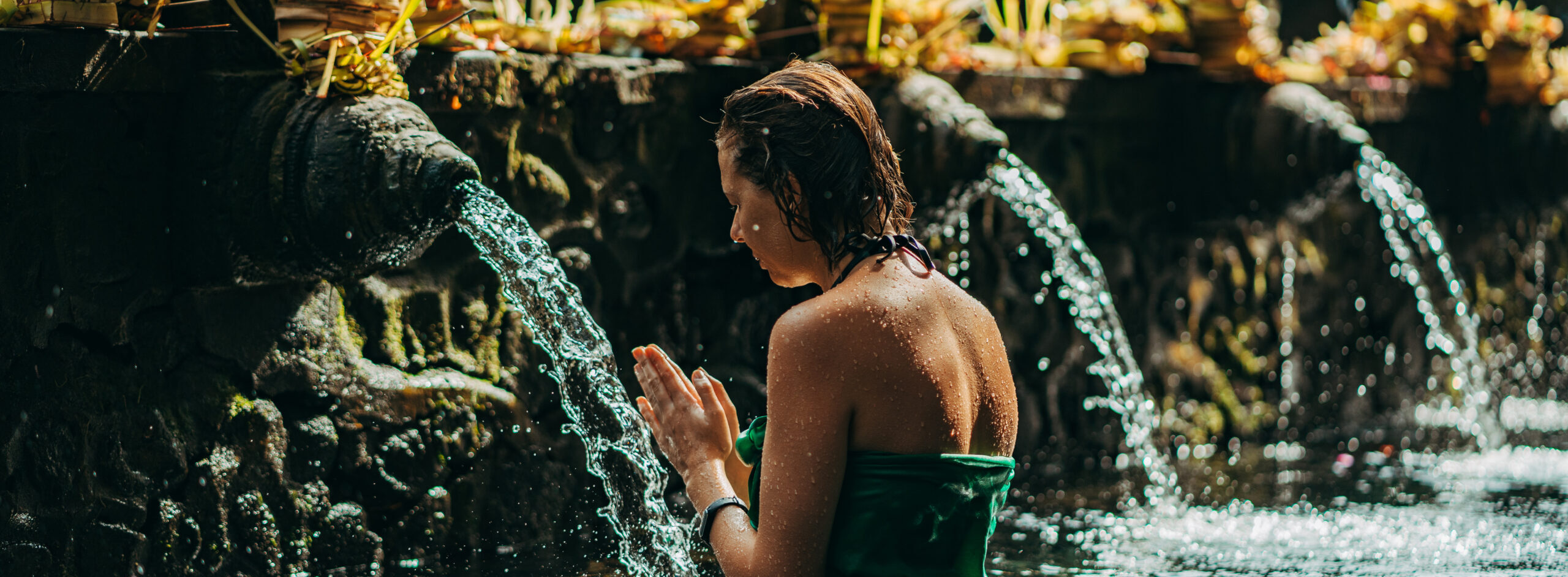








It’s no wonder Bali is called the “Island of the Gods.” With breathtaking landscapes that include pristine beaches, lush jungles, and iconic terraced rice fields, Bali is a must-visit destination for those seeking adventure, tranquility, and spiritual connection. Steeped in history, Bali’s heritage dates back to the Paleolithic era, with Hinduism and Buddhism leaving a lasting cultural impact during the 14th and 15th centuries. Discover the beauty and charm of this unique island with Gray Line Indonesia, your trusted expert for Bali tours and travel planning. Book your unforgettable day trips today!
Tour Expert, Gray Line Bali

Meaning “Land in the Sea,” Tanah Lot is one of Bali’s most iconic and photographed temples because of its striking cliffs and breathtaking ocean views. Perched on a large rock formation just off the southwestern coast of Bali, this sacred site stands as a testament to the island’s rich cultural and spiritual history. Tanah Lot Temple was built in the 16th century to honor Bhatara Segara, the god of the sea. Priest Dang Hyang Nirartha chose this location strategically because of its powerful connection to the ocean. If possible, plan your visit during low tide for the easiest accessibility and chance to receive blessings from local Hindu priests.

Nestled on the Bukit Peninsula in Bali, Padang Padang Beach runs approximately 110 meters long and is well-known for its crystal-clear waters, fine white sand, and backdrop of dramatic cliffs. To reach the water, guests need to descend about 120 steps through a rocky entrance, which gives Padang Padang an air of exclusivity and seclusion. In the 1970s and 1980s, the beach catapulted onto the international stage as part of the professional surfing circuit. It also graced the silver screen in the 2010 Julia Roberts’ film, Eat, Pray, Love. For surfing beginners, register for some lessons from one of the many local shops or take on the left-hand reef break if you’re more intermediate or advanced in skill.

Ubud is often known as the spiritual and cultural heart of Bali, particularly as it has evolved into a worldwide hub for yoga retreats, meditation centers, and holistic healing practices. Situated among lush rice terraces, green hills, and ancient temples, Ubud is a great place for some spiritual introspection and self-discovery. Join daily yoga classes in serene open-air studios or take a guided hike through traditional fields of paddies. There are few better ways to connect with Bali’s spiritual center than an experience in Ubud!

Also known as Tari Kecak, the Kecak Fire Dance is one of Bali’s most celebrated traditional art forms. It combines elements of dance, drama, and spirituality that coalesce into a powerful storytelling experience rooted in the ancient Hindu epic of the Ramayana. Developed by a Balinese artist in the early 1930s, the performance incorporated elements of the sanghyang ritual, a trance-like series of movements that symbolized divine communication. Typically performed at sunset, the Kecak Fire Dance features a group of 50 to 100 male performers who engage in synchronized chanting and act out different scenes from the Ramayana. As part of the show’s incredible conclusion, the dancers engage in a variety of daring fire stunts that reinforce the importance of values like loyalty, courage, and the triumph of good over evil.

As one of Bali’s most famous and established traditional markets, the Sukawati Art Market is a vibrant shopping experience where tourists and locals alike can explore a rich array of Balinese handicrafts, textiles, and artworks at highly affordable prices. With a multi-level layout in the Gianyar Regency, the Sukawati market is particularly recognized for its gorgeous silver accessories, wooden sculptures, and cloth made in the batik and ikat style. If you enjoy bartering over merchandise, you’ll have a great time at Sukawati as buyers are encouraged (and even expected) to haggle on the price of goods.

Mount Batur is an active volcano located in the Kintamani district of Bali. Its elevation stands at 5,633 feet (1,717 meters) above sea level and is a popular hiking spot for locals and visitors alike. Part of a complex volcanic system that includes a large caldera formed from an eruption 30,000 years ago, Batur itself has experienced eruptions in 1999 and 2000. Today, the volcano is actively monitored for visitor safety, which is good since hikes up its mountainside culminate in a truly stunning sunrise. Once making it to the peak, you may even get to cook eggs using the steam from the volcano!

Also known as Pura Tirta Empul, the Tirta Empul Temple is a renowned Balinese Hindu water temple located in the village of Manukaya in the Gianyar Regency. Famous for its holy spring water, this sacred site is a significant religious location for Balinese Hindus and visitors wanting to experience the famed purifying waters for themselves. Dating back to 926 AD during the reign of the Warmadewa Dynasty, the Tirta Empul Temple was allegedly founded by the god Indra, who created the springs to purify his warriors after they were poisoned by the evil king Mayadenawa. Ceremonies known as Melukat use 30 water spouts each associated with different healing and purification purposes located in the Jaba Tengah (Central Courtyard) of the complex. The temple is open to the public for a fee as long as visitors wanting to participate in the rituals wear appropriate attire.

Nestled among towering cliffs, Gunung Payung Beach is the slightly less popular alternative to Pandawa Beach in Uluwatu. As a more secluded location to get some sun, Gunung Payung Beach offers stunning views of the Indian Ocean and is accessible via a series of steep steps or dirt track road to a designated parking lot. Along with its beautiful white sand, the beach is also known for the many natural cave and rock formations in the area. As an additional bonus, local vendors typically set up stalls nearby so that snacks and refreshments are available without having to make the hike back up the hill.

Ulun Danu Bratan Temple is one of Bali’s most iconic Hindu water temples found on the western shore of Lake Bratan in the central Bedugul region. Perched at an altitude of about 3,900 feet (1,200 meters), the temple is surrounded by lush mountains and often shrouded in mist. This ethereal beauty has existed since the 17th century when the temple was dedicated to Dewi Danu, the goddess of water, lakes, and rivers. The Ulun Danu Bratan Temple also represents the importance of Lake Bratan to Bali’s irrigation system since the island relies heavily on its water to sustain agriculture. The temple itself is characterized by multi-tiered shrines called merus that each represent a different deity. Wander the temple’s complex on foot or take a boat ride for a guided tour of the beautiful water structure.

Located on Bali’s southwestern coast, Seminyak is renowned for its lively nightlife and sophisticated bar scene. A blend of upscale beach clubs that cater to a diverse crowd, the area is considered a premier destination for visitors looking for a fun night out on the island. Potato Head Beach Front is perhaps one of the most iconic spots in Seminyak due to its infinity pool, tropical cocktails, and lively party scene. Bali Joe Bar is also one of the most popular gay bars in the area and features regular drag shows and cabaret performances. Many upscale bars in Seminyak have a strict dress code, so make sure you bring the right clothes when visiting some of the more elegant venues!


Discover the Wonder of the Grand Canyon The Grand Canyon is one of the world's most iconic natural wonders. Carved ove[...]

At Gray Line Worldwide, our mission is to provide unforgettable experiences and showcase the best each destination has to[...]

Heading to an exciting new destination this winter? How about some of our best winter travel destinations? Don't forg[...]

That's a nice tour!
Clear and Easy!
Easy booking
Booking was very easy and straightforward. Best price is online, it is possible to pay on the bus on the day but is a little more expensive. Preprinted my voucher, gave it to attendant, all good.
Brilliant experience - Highly Recommend
Easy to book + discounted from the first journey with airport transfer on arrival to Iceland.